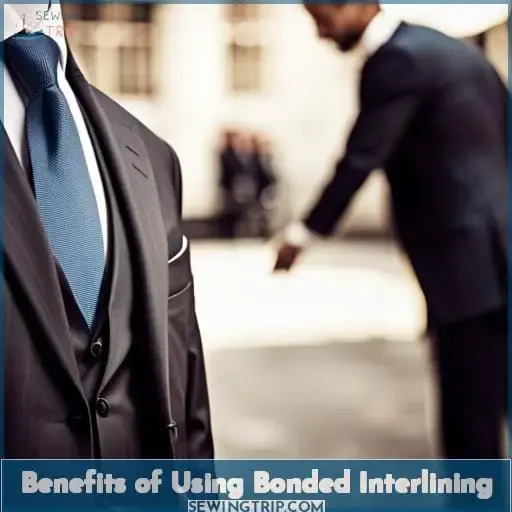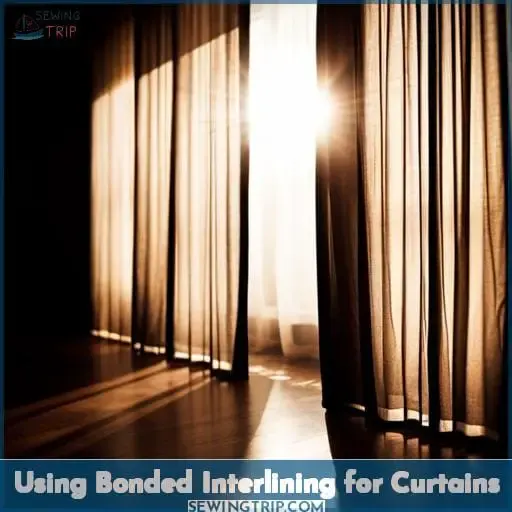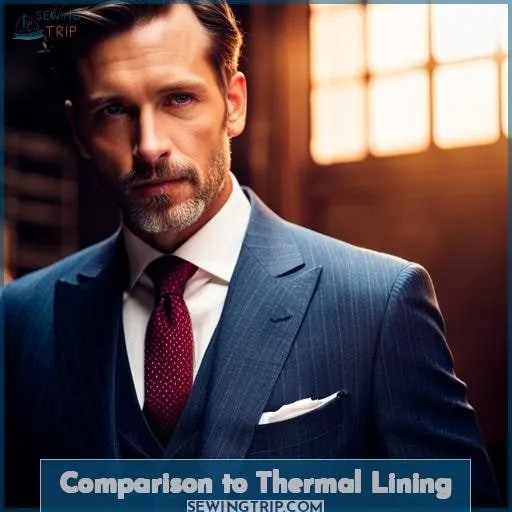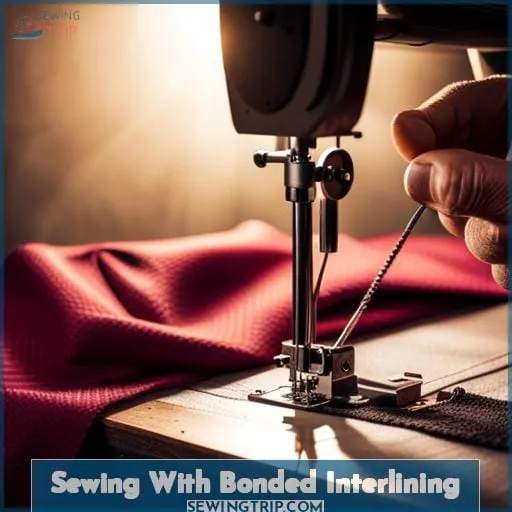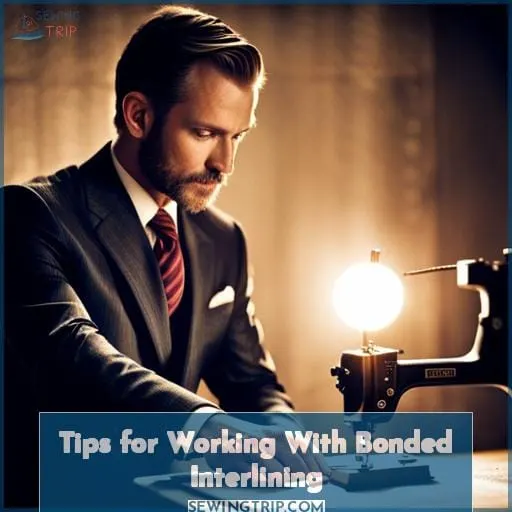This site is supported by our readers. We may earn a commission, at no cost to you, if you purchase through links.
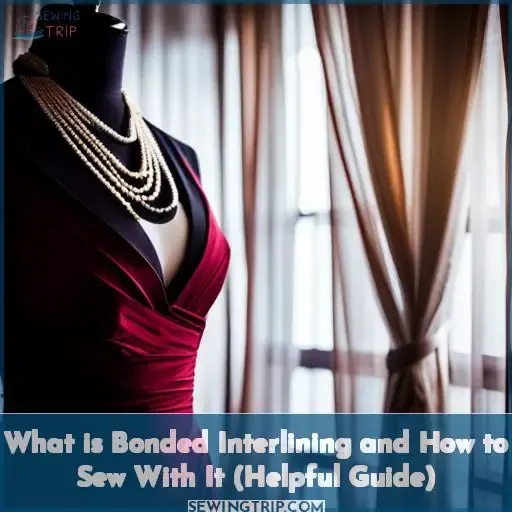 Bonded interlining is the perfect support system for curtains that need a boost, like a sagging window dressing. This sturdy fabric tucked between curtain and lining makes window treatments stand at attention.
Bonded interlining is the perfect support system for curtains that need a boost, like a sagging window dressing. This sturdy fabric tucked between curtain and lining makes window treatments stand at attention.
Bonded interlining lifts limp fabrics, provides insulation, and helps them drape flawlessly. Use it to perk up lifeless curtains or give shape to collars and sleeves. Compared to traditional interlinings, the bonded type saves time.
It’s fused on, eliminating the need to baste or stitch multiple layers together.
This article explains everything needed to know about working with bonded interlining. Tips will be shared on choosing the right product, measurements, and sewing techniques. With the proper interlining, full, flowing curtains and structured clothing can be created.
Table Of Contents
Key Takeaways
- Bonded interlining provides support, lifts fabrics, adds insulation, aids draping, and simplifies sewing for curtains.
- Bonded interlining increases warmth in winter and offers UV protection.
- Many pleat styles, such as pinch, goblet, accordion, inverted, and knife pleats, allow for customization.
- Bonded interlining is also used in bespoke clothing to stiffen collars and cuffs.
What is Bonded Interlining?
Bonded interlining is how curtains gain that substantial feel and hold their shape nicely. Acting as a lining, it adds body and structure. Featuring one fabric bonded to another, often cotton sateen and poly-cotton blends, it simplifies the sewing steps.
Carefully selecting fabric thickness provides insulation and fuller draping. When constructing curtains, hand-stitching the sides creates a softer finish. Used in apparel collars or interlined curtains, bonded interlining offers thermal insulation and simplified construction in one versatile fabric.
Benefits of Using Bonded Interlining
Bonded interlining provides several benefits when used for curtain making. Adding this fabric layer will help insulate your windows, block UV rays to help protect the curtains, and provide better drape for an enhanced appearance.
The bonded interlining can help insulate the windows by adding an extra layer of fabric to trap heat during colder weather. It also blocks UV rays from the sun to prevent fading or damage to the curtain fabric over time.
The additional layer creates a fuller, more structured drape as well to give the curtains a richer, more luxurious look when they are hung. With these combined benefits, utilizing a bonded interlining can greatly improve both the function and appearance of homemade curtains.
Insulation
Layering curtains with bonded interlining can help homes stay up to 25% warmer in winter. The interlining acts as a thermal barrier against drafts for more comfortable indoor temperatures. This heavy fabric blocks cold air infiltration while trapping heat inside. Consider using a polyester-cotton blend for the interlining’s insulating properties.
Careful hand-stitching maintains the drape and creates a softer, fuller appearance.
UV Protection
A fuller curtain appearance results from using thicker bonded interlining. Bonded interlining’s UV ray protection will preserve your curtain fabric by shielding sunlight and extending lifespan. This interlining type reinforces curtain durability against harsh UV rays. Blackout interlining fully blocks sunlight for total fabric protection.
Drape
Achieving a luscious curtain drape proves effortless when sealing bonded interlining. The stiff yet flexible fabric structure sways gently, accentuating your windows. Strategic stitching grants the perfect billow and flow. With this clever trick, your curtains elegantly frame the view beyond.
Using Bonded Interlining for Curtains
When making curtains with bonded interlining, pay close attention to the heading style and pleating options. Consider using pinch pleat tape, a buckram heading, or hand-sewn pleats to create the desired draping and fullness for your curtain project.
Varying the pleating and heading styles can provide customized fullness and a polished finish. Experiment with different widths of pinch pleat tape or varied spacing between pleats for a range of looks.
A buckram heading adds crisp structure, while hand-sewn pleats allow for soft, delicate gathering. Combine different techniques to complement your fabric and style. Thoughtful pleating and headings will elevate your custom curtains.
Heading Styles
For a more finished look with your curtain heading, consider using pinch pleat tape or buckram.
- Pinch pleat tape creates crisp, tailored pleats with consistent spacing between them.
- Buckram adds body and structure to create a smooth, rounded heading.
- You can sew curtain rings or clips into the heading for easy hanging.
- Heading styles like the goblet, inverted, or wave variations provide unique looks.
Pleats
You should pin pleats individually before attaching the heading to secure their shape.
| Type of Pleat | Fullness (%) | Curtain Aesthetics |
|---|---|---|
| Pinch Pleats | 100-300% | Uniform, elegant folds for a tailored appearance. |
| Goblet Pleats | 50-100% | Soft, rippled effect with movement. |
| Accordion Pleats | 50-100% | Crisp, stacked look. |
| Inverted Pleats | 50-150% | Soft drapes with depth. |
| Knife Pleats | 50-200% | Sharp, crisp lines in a narrow configuration. |
When selecting pleat types, consider the amount of fullness and visual style you want.
Comparison to Traditional Interlining
While traditional interlinings allow more softness, bonded interlinings provide structure and stiffness to curtains. To create traditional interlined curtains, the interlining’s cut separately then basted or pinned before sewing to the face fabric.
This enables the layers to move independently. Bonded interlining’s pre-fused. The lack of movement makes curtains hang straighter with a crisper drape.
Interlining also stiffens collars, cuffs, and waistbands in bespoke clothing. Unlike ready-to-wear, bespoke garments are fully interfaced allowing the fabric to hold its shape.
When hemming curtains, hand sewing creates a softer, more delicate edge compared to machine stitching.
Ultimately, choose interlining type based on the garment design and desired fabric structure.
Comparison to Thermal Lining
When it comes to comparing bonded interlining and thermal lining, there’re some key differences to consider beyond just insulation. Thermal lining tends to be softer and less stiff than bonded interlining, giving a more delicate drape to curtains and roman blinds.
However, bonded interlining can provide a fuller, more structured finish for a more formal aesthetic.
Test swatches of both to see how they behave before deciding. Thermal lining flows gracefully, while bonded interlining holds pleats and shape. You may even wish to experiment with combining the two in innovative ways to achieve your perfect drapery.
Though the insulation provided by both can be similar, the overall look and handle varies. Don’t be afraid to get creative and try alternative techniques to find what complements your space best.
Sewing With Bonded Interlining
When working with bonded interlining, remember to take precise measurements and hand stitch the sides and hem for a softer, more finished look. Meticulously measuring and cutting the bonded interlining to precisely match the exact finished curtain dimensions before assembly will prevent wastage.
Additionally, hand-sewing the edges provides a more graceful drape while better preserving the fabric.
Hand Stitching
Securing the sides and hem by hand allows a softer edge and better fabric preservation. When stitching with bonded interlining, use a slip stitch or invisible hem for optimal results. Work slowly and carefully, securing each inch with tiny stitches to achieve a smooth look.
For extra reinforcement, try a catch stitch every few inches. End by knotting threads securely inside the seam allowance. Proper hand sewing techniques create an invisible finish while preserving drape.
Varying your stitch length and alternating between slip stitch and catch stitch creates a more durable seam while maintaining drape and flexibility in the fabric. Take care not to pull threads too tight or make stitches too large to avoid puckering.
Patience and care yields professional results when finishing seams and hems by hand.
Measurements
Measure twice, cut once when working with bonded interlining – a few inches can make a world of difference in your finished drapes.
- Measure window length and desired fullness to calculate fabric requirements.
- Account for side hems and top headings when measuring curtain width.
- Mark fabric measurements in chalk before cutting to avoid errors.
- Determine what heading depth suits the style of your project.
Bonded interlining requires careful planning and precision in measuring to achieve the desired end result. Accurate calculations ensure you’ve ample fabric to work with. Marking cut lines visibly prevents miscuts.
Bonded Interlining for Clothing
When working with bonded interlining for clothing, focus on key garment areas like collars and sleeves that benefit the most from the added structure and support. Properly interfacing these parts will help your garment hold its shape and provide a crisp, tailored finish.
Collars
You’ll want to interface shirt collars with a light to midweight bonded interlining for structure without bulk. Seek out a fusible product to keep things crisp and creased. Cut the interlining on the bias, applying fusible adhesive to the wrong side before adhering it to the collar’s underlayer.
Use a pressing cloth to avoid shine. Bonded interlinings reinforce collars with stiffness yet subtle flexibility, framing the face for a refined aesthetic. Consider lightweight options like cotton voile to retain softness. Focus fusible application on the points for an enhanced collar outline.
Sleeves
Using bonded interlining in a garment’s sleeves gives them a stiffened, tailored shape that maintains its form over time. Interestingly, over 80% of suits feature bonded interlining in the sleeve construction.
Bonded interlining provides incredible stiffness to sleeves. It helps fabric hold shape and structure. However, some find it makes sleeves overly rigid. Consider a lighter interlining if maximum flexibility is preferred.
Proper stitching preserves sleeve structure. Compare softer thermal lining options when constructing jackets to bonded interlining options, which offer more structure but less flexibility.
Tips for Working With Bonded Interlining
Previously we discussed using bonded interlining for clothing items like shirts and jackets.
When sewing with bonded interlining, precise measuring is key to avoid wastage. Consider cotton sateen or poly-cotton blends for their fullness and insulation. For stitching, hand-sew the sides and hem for a softer drape. This allows you to skip steps like pinning and produces fuller, better insulated curtains.
Incorporate pinch pleat tape or buckram for curtain headings to hold their shape. Overall, bonded interlining simplifies your project by reducing workload and layers.
Keep these tips in mind for professional results:
- Take exact measurements to cut fabric
- Select a heavyweight interlining for fullness
- Hand-stitch edges for a soft finish
- Use pleat tape for sturdy headings
- Fewer layers streamline the sewing process
By following these guidelines, you’ll create stunning, well-draped curtains unique to your home. Bonded interlining provides ease and insulation to upgrade your window treatments.
Conclusion
At the end of the day, learning how to skillfully utilize bonded interlining can help you unlock your creative potential as a seamstress. While challenging at first, bonded interlining provides you with the tools to take your work to new heights.
Approach it with patience, allow yourself to experiment, and let it elevate your sewing skills to the next level. With practice, this versatile interlining will become your trusted partner, opening the door for you to craft unique garments and soft furnishings full of style, quality, and your personal flair.

